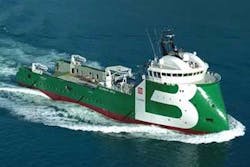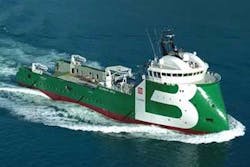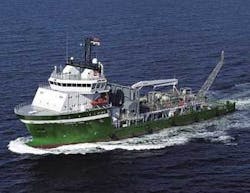Bourbon expands global fleet in bid to dominate support vessel sector
Jeremy Beckman, Editor, Europe
High day rates in the North Sea and contract renewals off West Africa helped Bourbon Offshore turn in a strong performance last year, with revenues up 36% to over €376 million ($507 million).
In 2006, the rapidly expanding support vessel contractor pressed ahead with its global fleet renewal program, commissioning 31 newbuild vessels, including anchor handlers, crew boats, platform supply vessels (PSVs), and fast-supply intervention boats.
This February, the company announced plans for a further 46 new vessels, of which 44 will be built by SinoPacific Shipyards in China, and two by West Atlantic Shipyard in Nigeria.
The $993-million investment covers:
- Twenty-eight GPA 254 anchor-handling tugs and supply vessels (AHTSs), with 80 tons traction
- Fourteen GPA 654 PSVs
- Four Ulstein PX105 MACS PSVs.
These latest orders bring the number of supply vessels on order to 110, all of which are scheduled for delivery by September 2011. By that point, Bourbon aims to be the global leader in maritime services for the offshore industry, with a larger pool of multipurpose vessels for deepwater construction support, a market currently growing at over 10%/year.
Design innovations
The three latest series of vessels on order will all be built from new designs. All of them incorporate diesel-electric propulsion, providing 20-30% savings in fuel consumption, according to Bourbon Offshore Managing Director Christian Lefevre. The diesel-electric configuration also eliminates the need for drive shafts, and the relocation of the main engines from the normal below-deck position frees up extra cargo space.
In the case of the DP-2 class GPAs 254 and 654, the propulsion system comprises three main engines and three Z-drives, with two 750 hp bow thrusters and azimuth propellers. The AHTSs are 60 m (197 ft) long and 1,400 dwt. The 1,600 dwt GPA 654s - with an overall length of 58 m (190 ft) - are the smallest supply vessels in Bourbon Offshore’s range. They will be capable of working in shallow water and deepwater and will have storage capacity for up to 4,000 bbl of liquid mud in oval-shaped tanks.
“Both these new designs will be adopted by all of the customers as replacements for aging members of the competitor fleets that they are using at the present time” Lefevre says. “They will be a great improvement over existing conventional supply boats, capable of carrying loads over 1.5 times greater, with maneuverability very much comparable to that of dedicated deepwater vessels.”
The four 88.8-m (291-ft) long, 4,400 dwt Ulstein Design PSVs offer three main innovations. First is the single-deck, X-Bow hull form, patented by Ulstein and first featured on theBourbon Orca, which entered service offshore Norway last year.
The inverted bow, curving inward as it rises, is designed to reduce slamming and to improve the ship’s stability, fluidity, maneuverability, and cruising speed, especially in rough seas (in calm waters, motions are claimed to be similar to those of conventional PSVs).
Secondly, the engine exhaust is positioned on the water line, eliminating the need for funnels. This gives the navigation team a virtually unobstructed view from any position on the bridge.
The third innovation is the Multi Application Cargo Solution (MACS) tank arrangement, developed jointly by PG Marine, Bourbon Offshore Norway, and Ulstein. This provides combination tanks that are capable of handling different types of cargo from drill cuttings to dry bulk and synthetic fluids without the need for conventional pressure tanks.
Aside from a larger, more versatile fleet, Bourbon’s growth strategy involves penetrating new markets via partnerships with local players, Lefevre says. He points to the example in Nov. 2005 when the company formed a joint venture in Singapore, called Bourbon Offshore Asia, with local entrepreneur Farid Khan.
As managing director of the new seven-man operation, Khan helped Bourbon raise its offshore revenues in Asia last year nearly fourfold to $12.24 million. New business included a two-year contract with Shell Sarawak for theBourbon Alexandre, one of five newbuild 120 t AHTSs delivered recently by Keppel Shipyard in Singapore. Elsewhere, the company now has four crewboats operating for Total Indonesie. This is in addition of the four “T” class AHTS and one Rampage series AHT currently working in India. Bourbon Offshore Asia also recently won a two-year contract (letter of intent) for one of the 70 t BP “S” AHTS, which will operate in the Gulf of Thailand.
Bourbon Offshore has decided to allocate three brand new AHTSs to the region this year. “At the moment,” says Lefevre, “the largest operator locally is Swire, which has seven or eight new vessels under construction, and there are several other Singapore-based ship owners like Scomi, Esra, PaccHavila. So there is competition, but we believe Bourbon is very well positioned.”
On the other hand, the overall fleet is aging, while at the same time, the trend is increasingly toward deepwater developments. “We think that with our GPAs 654 and 254 newbuilding program, we will be able to meet these future demands. We chose to develop this partnership with a good professional who knew the area and the industry locally and who speaks the language. Our new venture will grow by having to operate vessels built mainly in China - we see Malaysia, Indonesia, Thailand and Vietnam as the main markets,” Lefevre says.
Another new venture is Naviera Bourbon Tamaulipas in Mexico, based in Tampico. Naviera Tamaulipas was a family-owned shipping company, established 25 years ago and managed by Captain Gerardo Sanchez Schutz. The company had a fleet of three modern PSVs, all built after 1999, and seven utility and small supply boats, which were quite old, Lefevre says. “When we formed this venture, each company agreed to allocate three of its vessels. In our case, we contributed one 125-ton bollard pull anchor handler and two crew boats, all brand new. This month, the joint venture will also take delivery of a new MPSV, built in China.”
Pemex is expanding its operations in the Mexican sector, Lefevre says, but there is a shortage locally of modern tonnage vessels. “In many places, Pemex wants to have a more modern and more capable fleet to match its new technologies and offshore equipment. Also the company’s exploration effort is going deeper and deeper, which in turn demands bigger anchor handlers as well as bigger platform supplies,” Lefevre explains.
Naviera Bourbon Tamaulipas has a shore base with facilities in a nearby harbor. It employs 30 personnel, including administration staff. “The Mexican crews on the new tonnage crew boats were trained by American skippers. We also brought in captains and chief engineers from Europe to train the crews of the anchor handlers and PSVs. From our experience, Pemex is a very well organized and demanding company, running the same standard operation as Petrobras does in Brazil,” Lefevre says.
A third new venture is Bourbon Gulf in Qatar in partnership with the Jaidah family-owned ENSRV Group. This JV was formed in June 2006 as a small operation, initially supplying a Surfer 220 crewboat to Total. Subsequently, Total agreed to a new five-year contract for a Surfer 2800. In this region, these vessels, with their cargo-carrying capacity, offer an alternative to helicopters, the primary transport medium for offshore crews.
Recently, Bourbon Gulf won a contract for two AHTSs - both currently under construction in China - which will be chartered shortly by local operator Zamil on behalf of Saudi Aramco.
Elsewhere, in the group’s established markets, Brazil’s deepwater construction boom is continuing, with 55 AHTSs operating in the region. Bourbon acquired its local subsidiary here, Delba Maritima Navigacão, in 2001; this became the first vessel operator to build AHTSs in Brazil under an eight-year contract from Petrobras. Since last year, Delba Maritima has operated four AHTSs in the Campos Basin, and at the end of last year, the fleet was increased in size with the addition of the newbuildLars Grael, which was delivered from China. The Lars Grael will work offshore northern Brazil.
“Offshore West Africa,” Lefevre says, “we are working with the same major oil companies as before, although our level of activity has been growing with BP in Angola and ExxonMobil and Shell in Nigeria.”
Earlier this year, the group’s Sonasurf subsidiary won a long-term field support vessel contract from BP for the Greater Plutonio development in block 18. This was in association with Oceanteam Power & Umbilical, which has an agreement with Bourbon to supply subsea construction vessels for projects in West Africa and the Middle East.
“During 2006,” Lefevre adds, “we picked up a new client in Nigeria, Addax, for anchor handlers, and we worked with Amerada Hess for the first time off Equatorial Guinea, where we have an inspection, maintenance and repair vessel.”
Last year in the North Sea, day rates for PSVs were strong on the spot market, even in December. “Like other operators in this region, we foresee another good level of activity this year. Beyond 2007, there is a risk of over-supply in the PSV sector, less so for anchor handlers”.
In the case of Bourbon, Lefevre says, there are five PSVs on long-term charter, two with BP Norge. “TheBourbon Topaz is working for Statoil/Hydro on their projects in the Tampen area of the Norwegian North Sea; at present, we have no vessels doing duty in the Barents Sea. In the UK sector, we have a small standby vessel, the Bourbon Eko, on long-term charter to ConocoPhillips.”
Off North Africa, the company has three AHTSs in service off Tunisia, Libya, and Egypt, where Bourbon is about to open a marketing operation to deal with local operators. Other new centers include Bourbon Logistics Indonesia, formed late in 2005 on undeveloped land in Kalimantan in Borneo. This will provide oilfield services to several major oil companies and contractors in Indonesia, Lefevre says.
Training centers
To manage and service the fleet expansion, Bourbon is looking to double its workforce by recruiting over 4,000 seamen worldwide, around half of whom will be officers. Many of them will then have to undergo training, for which the group is making intensive preparations.
At the end of this year, Bourbon plans to open an offshore simulator center in Marseille in southern France. The company has existing programs on dynamic positioning and safety. This new program will provide instruction in anchor-handler operations via an advanced simulator. An identical facility will be launched in Manila, The Philippines, in 2008.
Elsewhere, three vessels will be used as dedicated mobile training centers in West Africa, Asia, and Latin America. All will be certified by the Nautical Institute of London. Bourbon also plans further partnerships with local training facilities, such as the Gepmare marine instruction school in Cameroon, which the company already supports. In the absence of certified local programs, Bourbon Offshore now is training its Angolan officers in South Africa or sending its Nigerian officers to Singapore for courses in dynamic positioning.



